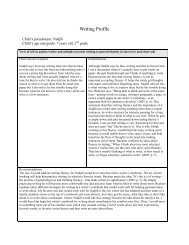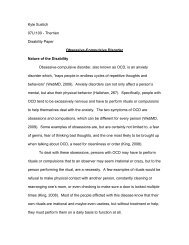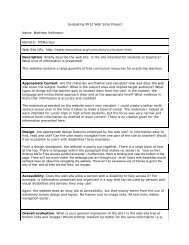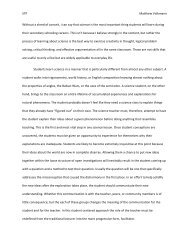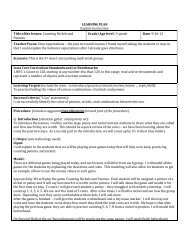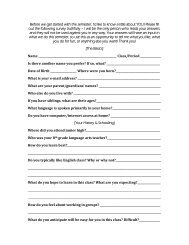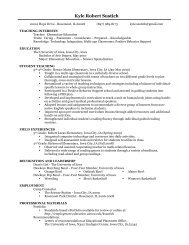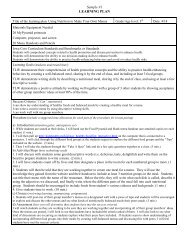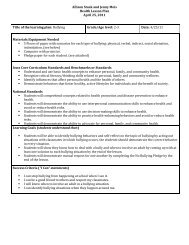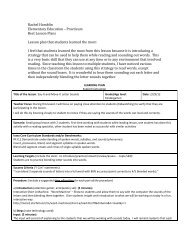Reading child study - Employment
Reading child study - Employment
Reading child study - Employment
You also want an ePaper? Increase the reach of your titles
YUMPU automatically turns print PDFs into web optimized ePapers that Google loves.
Your Name: Jenny Meis<br />
Child’s pseudonym: Nadjib<br />
Child’s age and grade: 2 nd grade, 7 years old<br />
<strong>Reading</strong> Profile<br />
View of self as reader and attitude towards reading (reported identity in interview and observed)<br />
Observations/examples<br />
Nadjib told me in our interview that he<br />
thinks reading in important because it helps<br />
people learn things. Although he thinks<br />
reading is important, when asked if he<br />
reads a lot at home he said no, he watches<br />
TV too much and reading is boring. If he<br />
isn’t interested in the book he fumbles over<br />
words a lot, skips whole lines of text, and<br />
has trouble concentrating. When the book<br />
isn’t a good fit for him he gets bored.<br />
Recommendations<br />
Interpretations<br />
Owocki & Goodman state, “I purposefully use this choice<br />
time to connect with kids and understand who they are as<br />
learners” (…, p. 1). While kidwatching, I notice he gets very<br />
interested in books when they are about “creatures” as he<br />
calls them. This can range anywhere from sharks to star wars<br />
characters. . As Hindly notes, “At read aloud time, choice is<br />
everything” (1996, p. 88). He has trouble picking out a book<br />
that he can get in to but once he does he seems to be very<br />
enthused when he reads it. I can tell when we are reading a<br />
book that he doesn’t like because he looks around a lot,<br />
fumbles over words, and reads at a slower pace. It is at this<br />
time that he does not view himself as a reader because he<br />
gets bored. I can see a big disconnect here when he says he<br />
doesn’t view himself as a reader because I think when he is<br />
reading a book he likes he enjoys it and would consider<br />
himself as a reader. Hindly expresses, “Often the books I<br />
choose contain fabulous stories that the majority of my<br />
students appreciate and love to discuss, but probably<br />
couldn’t read independently” (1996, p. 88). This is relevant<br />
because a lot of the books Nadjib brings me are much too<br />
high for his reading level. He is bored with the texts he<br />
knows and is able to read. Unconsciously he is ready to<br />
move to the next level of reading where in his opinion they<br />
would be much more interesting to him. He needs a new<br />
resource to find books and the best, most easily accessible<br />
resource starts with the teacher.<br />
To acknowledge that fact the he gets bored when reading the texts he knows that results in not thinking as<br />
himself as a reader , I would use the scholastic website to use their book wizard. It’s a great resource to find<br />
books of similar interest but an easier reading level. I could find books similar to the ones he brings me but<br />
look for something more in his reading level. This way I could work with him and other students in the<br />
class through mini lessons to improve their reading and reading strategies and at the same time through<br />
independent reading engage them with new books that cater toward their interests and in the correct reading<br />
level.<br />
Knowledge about genres and functions of reading (reported in interview and observed): What<br />
purposes does the <strong>child</strong> set for her/himself as a reader? What do observed behaviors show you what he/she<br />
knows about genres and functions/purposes of reading?)<br />
Observations/examples<br />
Interpretations<br />
When asked about different genres of<br />
reading, Nadjib had absolutely no idea what<br />
I was talking about. I explained to him that<br />
I believe the reason he didn’t know what genres were was<br />
because the word genre is a little difficult to grasp for second<br />
graders. This doesn’t mean that he doesn’t have any<br />
1
Spiderman is fiction because it’s made up<br />
and the book we just read about animals<br />
was a nonfiction book because it’s true. He<br />
then decided he liked fiction. He expressed<br />
his functions/purpose of reading was to<br />
learn things.<br />
Recommendations<br />
experience with different genres because he understood what<br />
I meant by fiction and nonfiction after I explained it to him. I<br />
students understand the concept but might not know the<br />
correct vocabulary for it. Nadjib expressed his reasoning for<br />
reading, to learn things. He is totally right but I think this<br />
needs to be elaborated to him a little more. Bell & Jarvis<br />
articulate, “And literacy wasn’t just about reading words. It<br />
was about reading all kinds of symbols that help us get along<br />
in our world-“(2002, p. 10). Nadjib doesn’t comprehend the<br />
fact that reading has so much to do with the rest of the<br />
world. If you can’t read, you can’t maneuver along in<br />
society independently.<br />
An easy way to introduce different genres of reading to younger <strong>child</strong>ren would be to explain to in a mini<br />
lesson what some types of genres are. After the mini lesson you could do centers with them and in each<br />
center have a different type of genre. Since they already have an idea of what different genres are an<br />
important piece of the center would be to stress the correct terminology for each center. Before you know<br />
it, you will have a class full of genre experts! One thing I would do if I had my own classroom to stress the<br />
different functions of reading would be to incorporate Donna Bell’s idea of a backpack dig. This activity<br />
would really make students understand that the importance of reading isn’t only to learn in school. It’s all<br />
around them in signs, directions, and even on TV.<br />
General Observed <strong>Reading</strong> Behaviors: Fluency, Book Handling, Attention to Illustrations, Etc.<br />
Observations/examples<br />
Interpretations<br />
While observing Nadjib’s reading<br />
behaviors in our weekly meetings I have<br />
noticed he reads word by word instead of<br />
reading by phrases and sentences.<br />
Something I noticed about his book<br />
handling skills are that he often picks out<br />
books that are much higher than his reading<br />
level. He also pays a lot of attention to the<br />
illustrations throughout the books he reads.<br />
Allington states, “Rereading occurs when we recognize that<br />
our reading seems to have gone off track and text it not<br />
making sense to us” (2006, p. 89). When he rereads phrases<br />
it means he doesn’t comprehend what the text he just read<br />
says and needs to reread it to find comprehension. It’s a<br />
good thing that he recognizes this and goes back to read it<br />
again. My interpretation of Nadjib’s reading fluency<br />
indicates that he is more of a low progress reader as<br />
compared to a high progress reader. Allington states “early<br />
readers making the greatest progress not only read faster and<br />
more accurately but also with better phrasing and intonation.<br />
Whereas the lowest-progress readers read aloud in one and<br />
two word segments” (2006, p. 91). Nadjib is in second grade<br />
he hasn’t had very much reading practice and is relatively<br />
new to reading. He often picks out books that are much too<br />
hard for him to read. Once he opens books about topics he’s<br />
interested in such as an informational book about Sharks he<br />
2
Recommendations<br />
see’s all the text and immediately closes the book giving up<br />
on the literature. According to Allington, this goes hand in<br />
hand with his hypothesis of why <strong>child</strong>ren don’t develop<br />
adequate fluency or rate of reading: “They have limited<br />
reading practice in appropriately leveled materials” (2006, p.<br />
95). When we were reading the page about Elephants in Life<br />
Size Zoo by Teruyki Komiya Nadjib stopped in the middle<br />
of the passage to look at the illustration after he read about<br />
elephant’s ear holes and where they were located. This<br />
allowed me to know that he comprehended the text and<br />
based on what he had just read he made a text to text<br />
connection to the picture and showed me where the ear hole<br />
was, as it was a little difficult to see. Miller suggests,<br />
“Asking <strong>child</strong>ren to recall the words or point out the picture<br />
keeps their connection text based and gives the rest of us a<br />
point or reference as we listen and learn from their<br />
thinking”(2002, p. 55-56).<br />
Based on his attention to illustrations and his ability to make text to text connections without my help<br />
shows that Nadjib is doing well with schema in his reading. To help correct his desire to reads book that are<br />
too difficult for him, I picked out another book about sharks that was more catered to his reading ability. It<br />
had much less text and he was able to read it with minimal miscues. I think this it in very important for him<br />
to have appropriate leveled reading literature in his hands for silent reading because books that are too hard<br />
for him aren’t going to aid him to move forward into a high-progress reader by improving his fluency. To<br />
address his fluency problem I would incorporate Allington’s (2006) idea of holding a small group choral<br />
reading. This approach has all the students in the group read aloud together. The important point in this<br />
activity teaches fluent reading that is practiced. If this approach doesn’t seem to be working, another thing I<br />
could try is echo reading. I would read a section of the text to him and then he would echo it back. This<br />
introduces new words and gives him a model of fluency. (p. 99-100)<br />
Evidence of reading strategy use (observed through weekly readings) How does your <strong>child</strong> construct<br />
meaning while reading? (Predicting, questioning, inferring, connections etc.)<br />
Observations/examples<br />
Interpretations<br />
A Strategy Nadjib uses while reading to<br />
construct meaning through readings is<br />
looking at pictures like he did in Life Size<br />
Zoo to make connections. He has the basic<br />
skills to make connections already but<br />
needs pushed a little to make bigger<br />
connections and practice questioning while<br />
reading. When asked what he does when he<br />
comes across a word he doesn’t know he<br />
simply answered “I just skip it.”<br />
On his own Nadjib does a great job making connections<br />
from text to illustrations to reinforce what he has read. I<br />
have noticed that he does this often throughout different<br />
books we have read. Miller states, “Readers know to infer<br />
when the answers to their questions are not explicitly stated<br />
in the text” (2002, p. 114). This is something I noticed<br />
Nadjib struggles with because when he comes across words<br />
he doesn’t know he often skips them or must mumbles<br />
something close to the word and continues on reading. Of<br />
course this ok to do when reading but he’s doing it<br />
unconsciously. In order to comprehend text you need to<br />
incorporate the use on context clues to try to figure the word<br />
When we read sometimes I will stop and ask him what he<br />
thinks will come next. He will think about it for awhile and<br />
then say he doesn’t know. out. Miller also suggests “Readers<br />
3
Recommendations<br />
make predictions about text and confirm or contradict their<br />
predictions as they read on” (2002, p. 109). Nadjib definitely<br />
struggles with this because he fails infer on his own and<br />
needs assistance to realize what to do in situations where he<br />
doesn’t know the word. Another important component of<br />
strategy use while reading is questioning. Miller states,<br />
“Readers purposefully and spontaneously ask questions<br />
before, during, and after reading” (2002, p. 125). This is<br />
something I have never witnessed Nadjib to do before,<br />
while, or after he reads. Questioning is an important thing to<br />
do while reading because it does a number of important<br />
things. It helps the reader stress upon themselves what they<br />
already know about the text and what they are learning. It<br />
also helps engage the reader because they move forward and<br />
read to answer questions they might have.<br />
Recommendations I would make for Nadjib to realize when he is skipping over a word he doesn’t know<br />
would be to practice inferring more on a regular basis. When we read a book about sharks it was the perfect<br />
opportunity to help him with this skill because it had a glossary in the back. I told him to mark words he<br />
doesn’t know with a post it and then we would come back to it later and find the meaning. Another thing I<br />
might do to help him understand the concept of inferring and predicting would be to have him read a<br />
wordless picture book. After each page in the book you could talk to him and help him pull out existing<br />
knowledge he has about the pictures and then help him transition what he already knows into a prediction.<br />
A great way to help him learn to question when he reads would be to use a KWL chart. Have him fill out<br />
what he already knows about the book before he reads it and what he wants to know. After finishing the<br />
book you could have him fill in the last part of the chart with things he learned from the reading.<br />
Miscue Analysis: What patterns are you noticing with the <strong>child</strong>’s miscues? Explain the <strong>child</strong>’s use of<br />
the syntactic, semantic and graphophonic cuing system.<br />
Observations/examples Interpretations: (describe the miscue in re: cuing<br />
4
Examples of high and low quality miscues<br />
Syntactic<br />
Nadjib had 24 syntactically acceptable sentences. An<br />
example of a high quality miscue includes:<br />
701 Together Sally and Scoot loved chasing<br />
around and around in the yard with the wind and<br />
happily consing in the long grass.<br />
701 Together Sally and Scoot loved chasing around<br />
and around the yard with the wind and then happily<br />
collapsing in the long grass.<br />
He had 5 not syntactically acceptable sentences. An<br />
example of a low quality miscue includes:<br />
1202 Scoot never been out of a big way world<br />
before.<br />
1202 Scoot had never been out in the big wide<br />
world before.<br />
Semantic<br />
He had 21 semantically acceptable sentences. An<br />
example of a high quality miscue includes:<br />
1001 Sally called him back, but Scoot ran down the<br />
yard and over the fence…and landed on the field of<br />
the other side.<br />
1001 Sally called him back, but Scoot ran down the<br />
yard and over the fence…and landed in the field on<br />
the other side.<br />
He had 8 not semantically acceptable sentences. An<br />
example of a low quality miscue includes:<br />
101 In a little house not far from here, the edge of<br />
the big grassy yard suprode by fields and he hills,<br />
lived Sally and Scoot<br />
101 In a little house not far from here, at the edge of<br />
a big grassy yard surrounded by fields and hills, lived<br />
Sally and Scoot.<br />
Graphic Similarity<br />
For Graphic Similarity Nadjib had 7 words with no<br />
graphic similarity, 3 with some, and 7 with high<br />
graphic similarity. An example of a high quality<br />
miscue would be when he said “he” instead of “it.”<br />
An example of a low quality miscue would be when<br />
he said “a” instead of “in.” I also noticed all his<br />
nonsense words have graphic similarity. Another<br />
thing I noticed is that all of his low graphic similarity<br />
miscues deal with parts of speech, mostly articles. A<br />
high percentage of these words were substituted with<br />
another word in the same part of speech. All of his<br />
nonwords had high graphic similarity except for one<br />
and my last observation is of him saying “big wide<br />
systems)<br />
Syntactic<br />
In the example of a high quality miscue Nadjib<br />
added the word in, omitted the word then, and said<br />
consing instead of collapsing. I said this was a high<br />
quality miscue because chasing around the yard and<br />
chasing around in the yard mean the same thing and<br />
are both used interchangeably. By adding the<br />
nonword “consing” I argue that it makes sense<br />
because he exchanged a verb for a verb. The reason I<br />
used sentence 11 for a low quality miscue is because<br />
saying “Scoot never been out of the big way world<br />
before” does not sound like language the way we<br />
would say it and it does not make sense with the<br />
story. Saying big way world instead of big wide<br />
world changes the meaning entirely because big way<br />
world makes absolutely no sense therefore it means<br />
nothing in our language.<br />
Semantic<br />
I used this example for a high quality semantic<br />
miscue because when Nadjib says “landed on the<br />
field of the other side” makes sense because in<br />
normal language we could say landed on the field<br />
instead of in the field and think nothing of it.<br />
Normally you wouldn’t say “field of the other side”<br />
but in my opinion adding the word of doesn’t change<br />
the meaning of the sentence and it still makes sense<br />
with the story. I consider the sentence that I chose<br />
for the low quality miscue low quality because<br />
simply reading “In a little house not far from here,<br />
the edge of the big grassy yard suprode by fields and<br />
he hills, lived Sally and Scoot” makes absolutely no<br />
sense. Nadjib didn’t say anything in the retell about<br />
where Sally and Scoot lived and he couldn’t<br />
remember when I asked in the aided retelling either.<br />
This tells me the semantics aren’t correct in this<br />
sentence because he didn’t comprehend where Sally<br />
and Scoot lived so it couldn’t have made sense to<br />
him within the story.<br />
Graphic Similarity<br />
According to GWB, “nonproficient readers often<br />
overuse graphophonic information and consequently<br />
have higher scores on graphic and sound similarity<br />
than more proficient readers” (2005, p. 90). This<br />
quote would indicate that Nadjib is borderline<br />
between a proficient reader and a nonproficient<br />
reader because he had 7 words with high similarity<br />
and 7 with low similarity. Since all of his non words<br />
5
world.” It’s said 3 times throughout the book. The<br />
first time he said big “way” world, he second time he<br />
said big “wind” world, and the final time he said<br />
wind but then self corrected it to wide.<br />
Retelling (Unaided followed by aided as needed)<br />
had high graphic similarity except one, this tells me<br />
he needs to work on reading strategies that integrate<br />
the use of sampling, inferring, predicting, and<br />
confirming graphophonic cues. In my opinion this<br />
would be the most important cue system to work<br />
with him on.<br />
Since Nadjib had 18 sentences with no meaning<br />
change, 4 sentences with minor changes, and 7 with<br />
major changes. This tells me while he is reading;<br />
he’s concerned with making meaning of what he<br />
reads and this indicates he is a proficient reader.<br />
GWB expresses, “In general, proficient readers<br />
correct a higher percentage of low-quality miscues<br />
(those that result in unacceptable sentences) than<br />
less proficient readers do” (2005, p. 87). Throughout<br />
the miscue analysis he self corrected 8 low quality<br />
miscues and 6 high quality miscues which is why I<br />
perceive him as a proficient reader. I would also like<br />
to point out that he self corrected he and Scoot<br />
twice. These are definitely high quality but I’m not<br />
sure if I would really count that toward a self<br />
correction or not because it honestly could be<br />
written either way. He also had a lot of uncorrected<br />
miscues in the beginning and middle but toward the<br />
end he self corrected all of his miscues semantically<br />
and syntactically which in my opinion is also a sign<br />
of a proficient reader. GWB also says, “Analyzing<br />
how readers handle the same word or phrase across<br />
text is so important…” (2005, p. 88). This statement<br />
turned my attention to when Nadjib read “big wide<br />
world” and also reinforced my view of him as a<br />
proficient reader. The first and second time he read<br />
it he said “way” and “wind” whereas the last time he<br />
read it he said “wind” and then corrected it to<br />
“wide.” I say this reinforces him as a proficient<br />
reader because after seeing it twice before he<br />
recognized it when it was being used through<br />
context clues and realized what the word was.<br />
6
Observations/examples<br />
Provide a holistic score of 1-10<br />
My observation of Nadjib’s retelling of the story is<br />
that he read with most comprehension. He was able<br />
to tell me the plot of the story with minimum details<br />
and within the aided retelling he was easily able to<br />
tell me what he had missed in the unaided. The only<br />
part he had trouble with was in the beginning where<br />
it said where Sally and Scoot lived.<br />
Interpretations<br />
Recommendations based on analysis of all three cue systems and retelling<br />
Wilde states, “An important principle of unaided<br />
retelling id not to assume that just because a reader<br />
doesn’t mention an element of the story, it doesn’t<br />
mention an element of the story, it doesn’t mean he<br />
isn’t aware of it” (Wilde, p. 49). Since he was able<br />
to tell me most of the story in the unaided I pushed a<br />
little further in the aided to prompt him remember<br />
the other elements. He was able to tell me that Scoot<br />
liked to chase seagulls, he jumped over a fence, he<br />
was in a farm, he thought it was fun, he didn’t feel<br />
good when he got lost and missed Sally, and he<br />
followed Sally’s voice to find her. He didn’t mention<br />
why he got chased so I asked him why Scoot ran<br />
away. He was able to tell me the correct answer that<br />
Scoot spotted a red balloon. He was also able to tell<br />
me in the aided retelling that Scoot liked to chase<br />
things and they hunted monsters. He wasn’t able to<br />
tell me where Sally and Scoot lived and this is a<br />
result of his miscues in sentence one which resulted<br />
in no semantics or syntax and no retention of what<br />
the sentence meant. Since he self corrected more low<br />
quality miscues than high quality he is correcting<br />
miscues that would have disrupted meaning within<br />
the sentence which would have disrupted meaning of<br />
the story as a whole.<br />
One recommendation I have for Nadjib would be to work on lessons that work with the graphophonic cue system<br />
because that’s the one he needs the most work on. An idea would be to do a cloze exercise. You would give him a<br />
passage with words deleted. When he suggests words for the blanks he will realize many different words will work<br />
even with no graphophonic cues. This will help him understand that he doesn’t need to be so concerned with<br />
graphophonics when he reads (F & F, p. 93). The next important recommendation I have for him would be to give<br />
him a story with key words deleted to create lessons that focus on semantics. Students can then get in groups to<br />
figure out what words could be correctly inserted in the blanks. This exercise would help him be more conscious of<br />
the important connecting words that show relationship between ideas (F & F, 94). Something to help him with his<br />
syntactic cues could be to have him rewrite a play as a story. This activity would help him be more aware of the<br />
differences in syntax between two kinds of speech (F & F, p. 93). Another thing I would do with him in a future<br />
aided retelling would be to ask things a in a more discrete way. For instance, Wilde has a good example of this in the<br />
article, “rather than asking Darcy early in the discussion “What about the people who went through the toll booth?” I<br />
asked, “Were their other people in the story?” (Wilde, p. 49). I think I could have asked Nadjib things in a better<br />
way to get a better understanding of what he retained from the story. The last recommendation I have for Nadjib<br />
would be to conduct a retrospective miscue analysis with him similar to Wilde’s in her article. I would tape him<br />
reading a story and then have him listen to his miscues. This is important because it allows the student to focus on<br />
what miscues to think about and helps him develop his own strategies. A drawback to this is it has potential to<br />
embarrass the student when they hear them self make mistakes. A good way to avoid this is to really focus and point<br />
out what they are doing right. It also builds self-respect about their knowledge and strategies (p. 60-61).<br />
Summary Summarize results; describe significant features of text/reading conditions; clearly identify<br />
strengths; state final conclusions. Write this section as if you are addressing the <strong>child</strong>’s parents in a report<br />
card.<br />
7
Dear Parents of Nadjib,<br />
I think it would be to great benefit for you to stress reading at home with Nadjib. He tells me that he<br />
doesn’t like to read at home because he gets bored. I am going to try my best to get books in different kinds<br />
of genres he’s interested in into his hands to bring home and read. I consider Nadjib a proficient reader but<br />
he needs some work on his fluency and phrasing. Choral reading is a great way to work on this skill.<br />
<strong>Reading</strong> a book out loud together or even having one of you read it first then him repeating it would help<br />
his fluency and stop his want to repeat. When he comes across a word he doesn’t know, he often mumbles<br />
something close to what the word actually is and skips it. Encouraging him to place a post it note where<br />
words he doesn’t know appear within the story is a good way to draw his attention to these difficult words.<br />
Then at the end of the story go back through and help him find the meanings to these words. He also needs<br />
work on inferring and predicting when he reads. A fun way to work on this with him at home would be to<br />
read a wordless picture book with him and before you turn the page have him tell you what he knows is<br />
going on based on the pictures and then from that knowledge predict what might happen next. During the<br />
miscue analysis I did with him, he had 18 sentences with no meaning change, 4 sentences with minor<br />
changes, and 7 with major changes. He self corrected 8 miscues that were of low quality and 6 miscues<br />
with high quality. This means that he is a proficient reader because he is self correcting miscues that would<br />
have disrupted the meaning of the sentence. This tells me while he is reading; he’s concerned with making<br />
meaning of what he reads. At the end, he did a great job retelling most of the major points within the story<br />
and with a little bit of help he was able to tell me the whole story. Overall, Nadjib is doing very well and I<br />
think a little bit of extra reading at home would help him progress faster into a great reader.<br />
Sincerely,<br />
Jenny Meis<br />
Class Recommendations: What structures will you put in place for your reading program? How will you<br />
organize time, choose materials, and work with students? Describe your reading workshop program.<br />
I would model my reading program after Miller because I really like the way she sets up her reading program in<br />
her classroom. The first and most crucial part of my classroom and reading program would be to have a<br />
classroom library with a lot of different book selection that are diverse in reading level and genre. I would have<br />
each student pick out new books each morning and have around 3-4 books in their desks at all times for silent<br />
reading. For each book they pick out I would have them keep a reading log on a bookmark. This would help<br />
them remember what they read and ensure that they are concentrating on comprehension. Each time they finish<br />
a book they would keep the bookmark in a folder turned in to me and receive a point. Once they build up<br />
enough points they would be able to “buy” something from the prize center. These bookmarks could also act as<br />
a way to remember all the books they read so they could suggest books to fellow students. Miller states,<br />
“<strong>Reading</strong> comes in to play throughout the day” (2002, p. 28). I think it is very important to read aloud to the<br />
students multiple times a day. I would read around 4 books each day. Thus would take place in the morning,<br />
after morning recess, after lunch (at this time I would read from a chapter book) and after afternoon recess. I<br />
think sitting the <strong>child</strong>ren down and engaging them in a great read aloud after times when they are transitioning<br />
from being active to needing to concentrate would be beneficial. After each read aloud I would have them vote<br />
on how well they liked the book to determine interest level, especially in my first years of teaching. I would do<br />
8
this by simply having a thumbs up, thumbs sideways, or thumbs down to indicate interest. This seemed to work<br />
well in the kindergarten classroom I observed in practicum. Throughout the year I would conduct mini lessons<br />
“focusing on modeling and identifying reading behaviors, and teaching and learning the expectations and<br />
procedures of the workshop” (Miller, 2002, p. 29). I would hold those mini lessons toward the beginning of the<br />
year and transition to important elements of reading structures and strategies in the middle to end of the year.<br />
For schema I would do a mini lesson over how to make text connections and do lessons over all the different<br />
types of text connections you can make. Then I would focus on making mental images. Miller expresses,<br />
“Readers’ images are influenced by the shared images of others” (2002, p. 82). This would be a good point to<br />
stress group interactions and group discussions of books. A great way to do this is to assign a couple students to<br />
different chapters of a chapter book I read in class and have them draw their opinion of important image or<br />
concept in that chapter. I would assign these before I start reading the book and keep reminding them each<br />
chapter that of the assignment. At the end of the book we would post these on an audit trail in the classroom and<br />
see how each student’s pictures differ from one another. Other things I would hold mini lessons over include<br />
inferring, predicting, asking questions, and synthesizing information. Another thing Miller talks about is book<br />
clubs and I think this would be a great thing to incorporate into my own classroom. I would hold a book talk<br />
about the books they were to read and let the students choose what book they want to read. Then I would “I<br />
meet briefly with each group the day before their book club meets and read the text aloud again; <strong>child</strong>ren follow<br />
along in individual copies” (Miller, 2002, p. 97). The last thing I would incorporate into my reading program<br />
would be reading centers based on Colleen Gallagher’s ideas from her website. I would place a certain colored<br />
dot on each student’s desk and this would correspond to what center they would be in each day. The dots on the<br />
desks would stay the same but the center dots change each day so the students would get a different reading<br />
center each day. One center would be a listening center where they listen to a book and follow along. Ideally I<br />
would have a couple iPod’s for the students to listen to a book and then they would do a worksheet which<br />
would include the name of the book, a picture of something that happened in the book and their rating of the<br />
book (1, 2, or 3 stars). Another center would be a word wall center where they would have different activities<br />
dealing with the words. Activities would include concentrations on consonants in the words, vowels, ABC<br />
ordering the words, syllables, and word wall pictures. Other centers would be an independent reading center, a<br />
making words center, making sentences center, and a guided reading center with me. The guided reading center<br />
would be leveled (as would the dots on their desks) and we would do things such as choral reading, taking<br />
turns, or anything that that specific group of students need further instruction with<br />
(http://www.teachingheart.net/LC.htm).<br />
9
Works Cited<br />
Allington, R.L. (2006). What Really Matters. Kids Need to Learn to Read Fluently.<br />
Bell, D., & Jarvis, D (2002, October). Letting Go of “Letter of the Week.” Primary Voices K-6 p. 10.<br />
Freeman & Freeman<br />
Gallagher, Colleen. (2007, July 13). Teaching Heart's Learning Centers Page. Teaching Heart. Retrieved October<br />
24, 2010 from http://www.teachingheart.net/LC.htm.<br />
Goodman, Y.M., Watson, D.J., and Burke, Carolyn L. (2005). <strong>Reading</strong> Miscue Inventory. Katouoh, NY: Richard<br />
Owen.<br />
Hindley, J. (1996). In the Company of Children. York, ME: Stenhouse.<br />
Miller, D. (2002). <strong>Reading</strong> With Meaning. Portland, ME: Stenhouse.<br />
Owoki, G. (1999). Literacy Through Play. Portsmouth, NH: Heinemann.<br />
Wilde<br />
10





